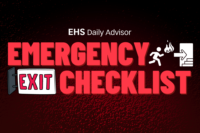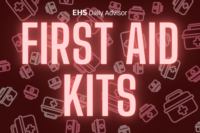No one wants it to happen, but an emergency, natural or manmade, can strike at anytime, 24/7. What’s more, it need not be a major, nationally-televised incident, such as a hurricane, earthquake, or act of political terror. An event as common as a local building fire can present just as large a challenge to you. These resources will help you create a plan for handling such crises, whatever their scope, and to carry it out in a way that best protects your employees and your company.
Free Special Report: 50 Tips for More Effective Safety Training
During a fire or another emergency, your employees need a clear exit route and clearly marked and unlocked exit doors. Your employees’ exit route must remain unobstructed by equipment or stored items, and employees must be able to exit the workplace through doors that are unlocked from the inside. Here’s a checklist based on a […]
Back to Basics is a weekly feature that highlights important but possibly overlooked information that any EHS professional should know. This week, we examine emergency exits and OSHA’s requirements for exit routes, doors, and other procedures. During a fire or another emergency, your employees need a clear exit route and clearly marked and unlocked exit […]
An updated standard for first aid kits was released recently that includes the required supplies and emphasizes that those supplies must meet the applicable performance requirements, according to an ISEA press release. The standard retains the kit classification of Class A or Class B based on the workplace environment, established in 2015, along with some […]
The purpose of an emergency action plan (EAP) is to protect employees from emergencies that may be reasonably expected to occur in the workplace. Is every employer required to have an EAP for its workplace? No. Does the Occupational Safety and Health Administration (OSHA) strongly recommend it? Yes. Should you have an EAP? Certainly, if you are […]
Oil spill emergencies pose threats to both the safety of workers and the environment. Here’s what you need to know about oil spill response.
Back to Basics is a weekly feature that highlights important but possibly overlooked information that any EHS professional should know. This week, we examine oil spills and OSHA’s recommendations for preparedness. Oil spill emergencies pose great threats to both the safety of workers and the environment. According to OSHA, employers are responsible for protecting workers […]
Whether it’s a fire, active shooter, natural disaster, or pandemic, employees should be trained to handle all types of emergencies. BLR Legal Editor Elizabeth Dickinson, J.D., recently spoke at a BLR Trends in 20 Webinar, where hot topics are discussed in 20 minutes, entitled “Prepare for the Next Emergency: Strategies to Address it with Confidence.” […]
What can employers learn from a well-rehearsed emergency action plan (EAP)? According to OSHA, almost every business is required to have an EAP. After evaluating your current EAP, is there more that could be done? How often should employers communicate their EAP to employees? Here’s what you need to know about emergency action plans. Check […]
On episode 143 of EHS On Tap, Dom Tolli, Senior Vice President of Product Management and Platform Development for the Training Services division at the American Red Cross, talks about the importance of having workers trained in basic lifesaving techniques.
On December 8, the Federal Motor Carrier Safety Administration (FMCSA) proposed limiting the scope of regulatory relief provided by emergency declarations, as well as the duration of regional emergency declarations (87 Federal Register (FR) 75206). Under current regulations, when the president, a governor, or the FMCSA issues an emergency declaration, drivers and motor carriers providing […]










